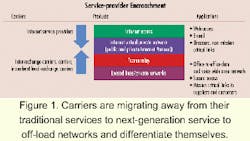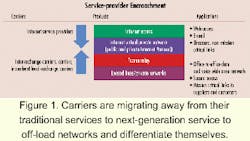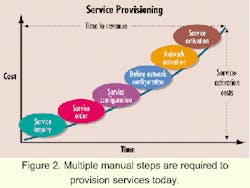Dynamic service provisioning at the optical edge
Service providers must differentiate themselves from their competitors; and the ability to offer new dynamic services to customers will be the key.
MATHEW STEINBERG, Redback Networks Inc.
From leased lines to legacy data services, today's access network has largely focused on connectivity. The network consists of an underlying transport network that multiplexes distinct traffic forms such as ATM, frame relay, Internet Protocol (IP), and time-division multiplexing (TDM) into time slots for transport between service vehicles before reaching the service destination. At least four different networks are supported with four different switching/routing elements and at least four provisioning and management systems. Because of the fixed bandwidth between these devices, a bandwidth bottleneck in metropolitan networks now exists between the high-bandwidth requirements of end users and the high-bandwidth capacity of core networks.
But because these existing TDM networks are so vast, it will take a good deal of time to evolve them, and any equipment used in this transition must support existing SONET/SDH functions and improve upon them. For service providers that have an embedded base of SONET/SDH networks, interoperability with the existing network and a migration path to a data- and service-optimized infrastructure is essential to minimize stranded investments. While traditional TDM networks are carrying the traffic that is bringing in the bulk of carriers' and service providers' revenues, these networks are inefficient and service deployment remains slow. As a result, providers are seeking to migrate from TDM networks and manual provisioning models to service-based networks with dynamic service-oriented provisioning models.
Technology alone is no longer a differentiator for the service provider. Bandwidth and access have fast become commodities, bringing with them low margins. Take basic Internet service, for example. In the very early days, people were often paying $3.95 for one hour of dial-up service. Today, it's possible to get unlimited access for $19.95 or less, if not free.
Not long ago, T1 (1.554-Mbit/sec) lines were limited to businesses with an information-technology (IT) budget. Now, small businesses and homes across America are clamoring for DSL service, because it provides similar functionality to a T1 for a fraction of the price. Since bandwidth services are still part of a required product offering, service providers are under tremendous pressure to lower the costs of these commodity services. They must also provision and modify bandwidth services rapidly. And they must protect their investments and maximize bandwidth utilization, while moving to the higher ground of value-added services.Though new equipment can provide immediate cost benefits, new revenue opportunities are essential for long-term deployment. The network must also transition gracefully from today's services to data and IP services. The transition to data and IP services must occur elegantly for both hardware and software. Service providers are first looking for capabilities that increase the bandwidth efficiency in their network. Bandwidth efficiency, however, only affects network costs. Service providers will look to platforms that enable new service and revenue opportunities. Platforms that can address today's desire to lower network costs and enable revenue opportunities stand the greatest chance of success.
Some service providers will opt to distinguish themselves based on value-added services, including service-level agreements (SLAs), service packages, unified messaging, sophisticated security, and content filtering. Value-added services enable service providers to differentiate themselves on something other than price. These services will provide new revenue streams, much like was done in the voice world with call waiting, caller ID, and other telephony services.
Today, there are basically two sets of service providers vying for the consumer and coming at service delivery from somewhat different directions, with the target being IP services. Interexchange carriers, incumbent local-exchange carriers (ILECs), and competitive local-exchange carriers (CLECs) are shifting their business models from leased lines and frame relay to support value-added services. These services begin with variable bandwidth, including virtual private networks (VPNs) to off-load existing TDM and frame relay networks and, later, more advanced services. Historically, ILECs and CLECs have competed on price. Now, the carriers must differentiate themselves based on service offerings.
Internet service providers (ISPs) are also pushing toward value-added services, moving up from basic Internet connectivity. ISPs are beginning to deliver security services as well as VPNs to differentiate themselves. Figure 1 illustrates the dynamic in today's market as service providers begin to encroach on each other's space.
While it is clearly growing, customer demand is also very unpredictable. The dynamic business environment means change is constant. Some customers need to be set up, while others need to be upgraded or disconnected. Thus, the specific end-customer requirements of interface type and interface rate are not well defined.
For optimum effectiveness, service providers must offer multiservice capabilities and a high degree of scalability. They must simultaneously meet these combined requirements for a high degree of interface scalability (e.g., line rate) as well as interface type (e.g., TDM, packet, etc.) Most importantly, the architecture must also be flexible to quickly deploy and scale services.
Today, business service deployment is both a time-consuming and costly process. From the time a customer calls to place a service order, multiple manual steps are required (see Figure 2). These steps include placing the order, determining the network configuration, and activating the service. Rapid service provisioning is one of the solutions that carriers and service providers can use as a competitive advantage in today's dynamic market. Due to the vast array of technologies and network elements in operation today, provisioning services creates a progression of tedious, manual steps across multiple network elements, usually from multiple vendors. Net-work complexity is also inevitable when provisioning services through multiple equipment interfaces.
Manual provisioning methods are time-consuming and costly, as well, since elements are provisioned individually. Some of the manual steps associated with provisioning include route selection, physical provisioning, equipment interconnection, and interaction with multiple management systems. Manual provisioning methods and manual element interconnection across multiple discrete elements can also be prone to errors. The service provider needs a practical means to administer moves, adds, and changes-and not an army of additional craftspeople.
Multiservice platforms (MSPs) simultaneously help meet unpredictable demand from end users while helping the service provider build a more efficient and scalable network. MSPs must maintain the robustness of SONET/SDH and provide a migration path to data and IP services. MSPs help the service provider build a more efficient network with fewer boxes, thus reducing cost and provisioning time. To help the service provider make money, the MSP must also be capable of provisioning new value-added services.
New elements and new services must also be complemented by improvements in network management, operations, and provisioning tools. While maintaining backward compatibility, the focus must be on automated service provisioning. With advanced management systems and flexible platforms, providers can finally deliver true customer-driven network management and provisioning. With this level of software-enabled provisioning, any connection or service can be established or changed, and circuits can be switched to different end points on a dynamic basis. This capability must exist at any time of day or just as part of the normal business cycle.End users want to seamlessly and securely connect individuals, regardless of their location. Self-service for the customer means visibility and control over the application traffic in the network, with an easy way to administer changes. Users span organizational and geographic boundaries as well as individuals within the enterprise (an intranet) and outside the company, for example, partners and suppliers (an extranet).
End users may also want to rent application services from an outside provider such as an application service provider to lower costs. The service provider must also assure and report that the traffic is flowing as expected. Self-service will encourage enterprises to subscribe to new services, removing the stumbling blocks to service adoption and ramping up new carrier revenue.
Traditional operation support systems (OSSs), however, are very rigid and slow to adopt new services, acting as a bottleneck for innovation and rapid service rollout. In many cases, it can take six to 12 months to roll out a new service and cost millions of dollars in system-integration work. Carriers should not replace this huge investment, but instead develop a complementary and agile services OSS.
A services OSS will allow providers to support customer requirements in near real time. A graphical user interface should provide "point and click" provisioning capabilities as well as a real-time graphical representation of one or more networks and network services. Graphical tools enable service managers to deploy, manage, and scale services quickly and efficiently as well as manage hundreds of thousands of subscribers and thousands of SLAs.
The ability to provide new dynamic services to end users is a key differentiating factor for service providers. Today's static service model focuses on connectivity, is difficult to provision, offers few commodity services, and is people-intensive. The dynamic model, in contrast, will empower subscribers with rapid and dynamic auto-registration, personalized service selection, secure service delivery, and real-time billing. Dynamic provisioning and service selection is enabled by a new class of network elements, multiservice platforms, and services-based OSSs.
Mathew Steinberg is director of marketing for Sunnyvale, CA-based Redback Networks Inc. He can be reached by e-mail at [email protected].


